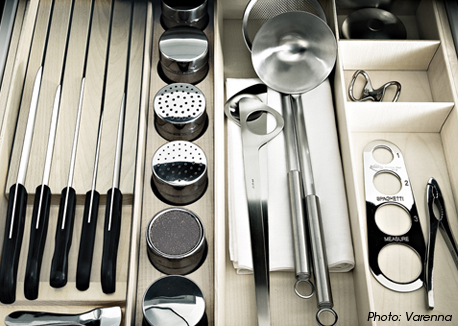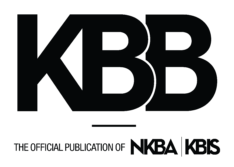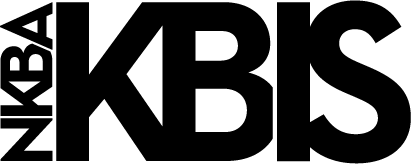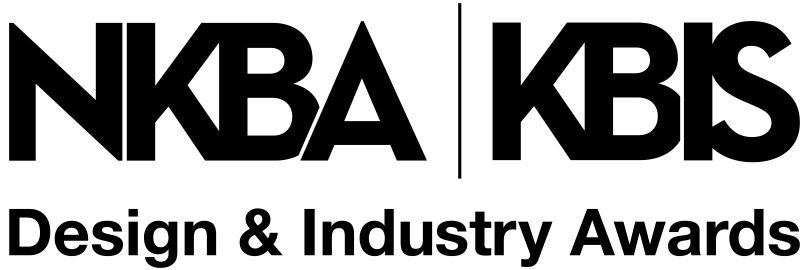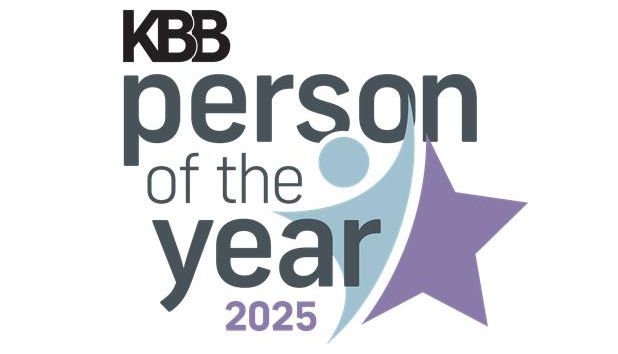Your clients would rather make dinner than reservations or they’d rather dial friends for some meal-making fun than the local pizzeria for the same old take-out. And yes, they’d prefer to invest more time in their own culinary creations than in their neighborhood restaurants. We all know these clients and have often designed kitchens for them. They love to cook and bake and, to the untrained eye, make it all look so easy. But could it be made easier for them? Our panel of experts—two award-winning kitchen designers and a top New York City chef—offer advice and suggest some tips on how to organize and reorganize this all-important room to best serve the needs of the at-home chef so they can best serve—and create—their edible art.
Yes, the market abounds with great gadgets and gizmos that promise to help today’s homeowner stay organized, and we’ll touch upon the ones our experts deem must-haves. But they all say that before you can physically get the kitchen in tip-top shape, you first need to delve into the psychology of the client, which means you should…
• Become a know-it-all. “Get to know them, really know them,” advised Joan DesCombes, CKD, owner of Winter Park, FL-based Joan DesCombes Kitchen Design. “This, above all else, is the key to creating a truly functional kitchen.” Our other two professionals completely agree: It all comes down to finding out whatever you can about them. “Sure, I ask them if they cook or bake,” said Peter Salerno, CMKBD, of Wyckoff, NJ-based Peter Salerno Inc. “This is critical information, but then you need to follow up. What do you cook or bake? Getting down to the detailed information is key to finding out just what they need and just where we need to put it.”
Executive Chef Michael Ferraro underscores this thought. When he’s not whipping up fabulous meals at New York City’s Delicatessen and Macbar, he’s often consulting on commercial kitchen design. “What works well in a restaurant easily translates to residential kitchen design,” he said. “When I’m asked to help out on other restaurants, I always start with finding out what type of restaurant it’s going to be, what will be served and the kind of space they’ll need to make it work.”
But it’s not only about posing the more obvious questions. It’s about asking the oft-overlooked ones as well. So, make sure you…
• Keep asking away. DesCombes has an impressive six pages of questions she runs through with her clients before beginning a job, be it new construction or remodel. They go from the very routine and general down to “How important is that cat?” DesCombes emphasized that digging down to the nitty-gritty is not just for serious at-home cooks, but for anyone that cooks. “Query the client so you can know everything about them that they’ll share with you,” she said. “Sure, start with ‘How tall are you’ and ‘Who cooks,’ but then delve deeper.”
For instance, some clients may claim not to cook, but after a little probing, you may discover “what they really mean is ‘not very well’ or ‘not very often’ or ‘I don’t, but my visiting chef does,’” DesCombes noted. “This is quite a different answer from the original assumption that ‘no one cooks’ and dramatically affects how you’ll proceed with the kitchen plan.” What if your client only cooks with a wok? You need to know this, because it “affects cooktop selection and ventilation choice, which, in the end, affects layout and ultimately, organization,” DesCombes said. This knowledge, however, won’t present itself without some persistence on your part.
Establishing trust is key to getting the answers, according to DesCombes, especially when you’re asking for information that is personal and even potentially sensitive. Make sure your clients know you’re using that personal information to create the best possible solutions. “The more the client trusts you, the more information you can get from the client and the better job you can do,” DesCombes explained. Don’t be afraid to ask less-obvious questions about lifestyle experiences, such as those relating to health and wellness. “Sometimes, people don’t want to talk about something unless it’s obvious,” said DesCombes. “Clients may not want to discuss becoming elderly or emotional issues, but you still need to find out what’s going on in the family so you can make their life work better and easier.”
If your client is more of a private person, DesCombes, who plays part designer and part therapist, recommends “being a talker and a listener.” Help your client realize that every bit of information they can share helps you create a more informed design. “We may not be social friends, but the client and I will become friendly and sit with a cup of coffee or breakfast and chat,” DesCombes added. Which brings us to this:
• Share their space. Have that friendly meal or chat on their turf. Observe everything. It’s the only real way to witness how they function. You need to know how they currently work in order to figure out how they will work. “Are they left- or right-handed? Witness how they operate and what they have firsthand,” Salerno said. “They may say ‘I’m short a double cabinet’ or ‘I need more pot drawers,’ but being there allows me to see how many they are actually using and how many they actually need.”
Of course, be sensitive to the client: You’re there to help, not to judge. “I’ve had clients that were embarrassed to have me in their kitchen,” said DesCombes. “They love to cook, drink wine, entertain, but the space was a mess—not only highly disorganized but also beyond organization, given what, and the amount, they had. What they really needed was clutter control.” This is what can happen, cautioned DesCombes, when a designer installs a kitchen without asking the right questions first—there’s no thought given to the habits and lifestyle of that particular client. But, she reiterated, you need to be gentle in your approach. Or better yet…
• Walk the talk. “I took cooking classes because it’s really important for me to know where my client is going to be in the kitchen,” said Salerno. “I went to The Culinary Institute of America (CIA) for the ultimate cooking experience. I saw what was involved, fell in love with the whole experience and have been able to incorporate what I learned into what my clients’ needs are.”
For Ferraro, this makes perfect sense. He spends his life in a kitchen and knows, really knows, what works to simplify the process. What’s easier: knives in a drawer or a block? Is it better to hang utensils from a rack or store them in a drawer? Identify with your clients by knowing what it’s like to be in a truly functional kitchen. All of this comes into play in determining how much space there is to work with and how things should be arranged to maximize that space.
• Meet their needs. Remember, organization is not so much about the space as it is about the people in the space. “You’ve done your homework and you found out whether they cook intensive and extensive dinners or the 20-minute quick meal,” said Salerno. “This dictates what utensils, pots and pans they’ll need to match the caliber of cooking.” Having this information, as well as all the answers to all your lifestyle questions, means that when you sit down to design the kitchen, you should already know pretty much where every item is going to go. As DesCombes said, “It’s done before anything else because it’s so much easier to organize than reorganize.” Let’s face it, in kitchen design you only have a finite amount of space. So what fits into that space?
Naturally, organizing and finding a place for all of your client’s belongings may require making tough decisions on occasion, DesCombes noted, especially if they have a lot of them. Take inventory of everything in the kitchen. Decide where you want to keep it or if they should keep it. Put less-used items in a designated area in the kitchen to free up valuable kitchen real estate for more oft-used ones. “Everyone has a story; you just have to help them write it,” said DesCombes. “Less-skilled designers never ask the right questions and wind up creating spaces with all of the bells and whistles, but in a cookie-cutter fashion.” You need to design the kitchen jointly with the client. If you impose your ideas on them, give it time and they’ll go right back to the old way of doing things.
• Design within reach. In the end, it’s all about the “at your fingertips” approach. So, all agree that creating separate stations, no matter the size of the kitchen, is beneficial to an organized kitchen. “Layout, as far as the equipment, is one of the most important things,” said Ferraro, a big advocate for bringing this professional tip into the home. “The number one mistake that I always run into is the placement of the appliances. You have to think about how the equipment is going to function with one another.”
As a solution, Salerno advises discussing appliances early on in the process, before any talk about colors or finishes. And try to include a variety of options. “A regular stove doesn’t cut it for people who like to cook, so get them excited about the possibilities,” he said. “They may not be aware of what’s out there and if you can get them on board by appealing to their interests, you can offer them the best solutions.”
 Homeowners who enjoy cooking may not be satisfied with a “regular” range, but they may not be aware of the latest product offerings, such as Thermador’s Pro Grand Steam Range, which is four appliances rolled into one.
Homeowners who enjoy cooking may not be satisfied with a “regular” range, but they may not be aware of the latest product offerings, such as Thermador’s Pro Grand Steam Range, which is four appliances rolled into one.This is particularly useful in choosing an appropriate range, which means the difference between a kitchen that really cooks and one that doesn’t. As Ferraro noted, “The range is the most often-used piece of equipment in a home kitchen.” Burner configuration, for instance, is huge to making the cooking space function properly. If everything needed to make a sauce, grill a steak or flip a pancake is there in one unit or setting, you’ll be the at-home cook’s best friend.
“Nowadays, they have combo units that have a range, a griddle top and a grill, and they’re right next to each other, which is great,” said Ferraro. “One of the most important things when you’re cooking is that the equipment is close by so that it’s efficient. This way, you’re not walking 3 ft. in one direction, then the other and back and forth.” Salerno agrees. He recommends keeping condiments, small appliances, cookware—“everything that goes with the cooking”—equally within easy reach. “The most frustrating thing for a chef is having to take more than two steps to access something,” he said. “Everything they need to make that meal should be a couple of steps from the stove.”
The same goes for a baking station. Pop-up mixers, dropped areas for kneading dough, a row of cabinets for cookie sheets and drawers for cake pans and cupcake holders should all be in the designated baking section of the kitchen. Grab this, grab that, easy as pie.
Also think in terms of how things get put away. Where will items be stored after they’re washed? Near the breakfast nook, near the dishwasher? It depends on what your client is comfortable with. Ask them. As a general rule, though, washing and storing works well when in the same area. Again, do you want to walk across the room and around the island with each glass or dish you need to put away? Probably not.
Which brings us to the must-haves for an organized kitchen. While these products will differ from client to client, check back for those Salerno, DesCombes and Ferraro consider essential.

